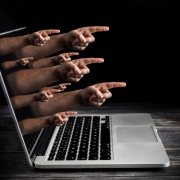When someone comes forward about cyber bullying, all too often their concerns are dismissed—or, worse, they’re told that they brought the situation on themselves. As with many other forms of abuse, the victim is sometimes told that they’re responsible for their own abuse. A new research published in Computers in Human Behavior links the amount of blame the victim receives to the aspect of social attractiveness.
Cyber bullying is now increasingly being seen as a public health crisis in Australia. In fact, approximately one-third of kids has experienced cyber bullying. However, only a few report the incidents to adults or the authorities. This can lead to more victims experiencing depression and anxiety, sometimes with life-threatening results.
One reason victims may hesitate before coming forward is the fear that they’ll be blamed for the cyber bullying behaviour of others. The new research attempted to understand and go deeper into this issue.
Why are Victims Blamed?
The British University conducting the research had more than 100 undergraduates examine screenshots of eight artificially created Facebook feeds. After looking at the feeds, the “victims” were rated by social attractiveness and how responsible they were for their behaviour. Researchers found direct correlations between the perception of social attractiveness and victim blaming.
What researchers saw was that if the victim received a significant amount of bullying from a single source, they were less likely to be blamed. However, when the victim received a low volume of bullying from a single source, they were more likely to be blamed. In the second case, it was assumed that something about themselves had caused the bullying or that they were somehow responsible for the hurtful things said.
In the first case, however, researchers believe that occasional bullying comments from a single source aren’t thought of as bullying, but as socially acceptable teasing or banter, especially when two people are going back and forth regularly.
What is Social Attractiveness?
Social attractiveness has to do with more than just whether someone looks good or not. Those who are seen as socially attractive are deemed likeable enough to receive attention from others. Also, if we can identify with or relate to someone better, they have a higher social attractiveness rating.
Interestingly, researchers found that victims were thought to be less socially attractive if they were only bullied occasionally by a single source. When they were bullied often by a single source, they were perceived as being more socially attractive, which seems to earn them less blame for the behaviour of others according to the study. Since we see the person as likeable and similar to us, we have more sympathy for them. Those who seem less socially attractive are more likely to be blamed for being bullied online or offline.
How Does This Affect Cyber Bullying Responses?
It’s important that parents and educators to not dismiss bullying as “kids being kids” and instead look at comments that can be interpreted as being malicious or abusive. Even if someone “didn’t mean it,” the impact of their words needs to be considered as carefully—if not more so—as their intent.
And it’s important to remember that children and students can both be victims and the cyber bullies themselves. It’s important for parents to watch out for both, and not assume that because their child is being bullied, they would never bully another kid. In all this, however, it should be clear that being bullied is never the victim’s fault.
At StarShell Student, we’ve created a platform that acts as a social media monitoring tool that filters online content and updates to protect children and students from the ill-effects of cyber bullying. It also acts as an educational platform that helps turn the youth into responsible users of social media. If you have any questions, please don’t hesitate to contact us today to learn more about how we can help.




